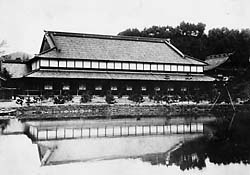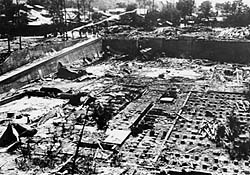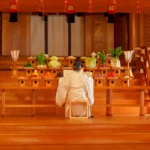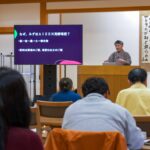By Ruth Reiner



Hi there. Well as I was saying last time, we are now really getting into the second Oomoto persecution which was quite a dramatic one. As with the first persecution, the main accusation was conspiracy, against the Emperor.
Onisaburo was sentenced to life imprisonment. One thousand Oomoto people throughout the country were subject to police investigations, and many to severe torture. In chapter 25 we can find a report given by a lawyer, with an outline of the happenings in the Second Oomoto Case.
The question might arise about why Oomoto was treated so harshly. I have mentioned in the last chapter some issues that may have aroused the suspicion of the authorities, and I would like to add some more in this item, ‘cause in my opinion it is quite fascinating, the various angles that Oomoto was accused from. Last time I mentioned Emperor Pu yi and the Esperanto activities.
One interesting example of how the authorities gathered their accusing evidence, we find in chapter 25. The head of the Police Department of the Ministry of Home Affairs at that time, wrote in later years an article titled “The Circumstances of the raid on Oomoto”. He claims that Onisaburo wrote many poems concerning the Imperial family. He mentions one that although he does not remember how it begins, he said that all he remembers, is that it ended with the folowing line: “Black clouds covering the Imperial Palace”. And he added,
“…it was easy to bring action because of such things under criminal code of the time…’.
The poem actually was the following:
The light of the moon
is unchanged as of old
but black clouds
cover the Imperial Palace.
(ch 25)
Itsuro Hayashi commented that Onisaburo wrote it out of grief at the illness of emperor Taisho, and not with disrespectful intentions. But as we all know that is the beauty of literature that it may be interpreted in many ways, and in Oomoto’s case the result of a “free interpretation” had deadly results.
There were claims of all sorts against Onisaburo, another being:
“Onisaburo having connections with right-wing militarists calling for armed revolution…” (ch 26)
All in all the accusations were countless and sometimes absurd. But the treatment towards Oomoto was severe. If you look at the pictures in this item you can see for instance how the main sanctuary had been destroyed. There are also mentions of torture of Oomoto people by the police, and that the foundress’ grave was even dug up. (ch 25 -26)
“Oomoto’s assets were sold for next to nothing by the state, it’s land was sold to the town for 8 sen per tsubo (four square yards for about the price of a packet of cigarettes). They threw vast numbers of objects into the dry moat and set fire to them, the fire continued to burn for a whole month. Over 1,500 charged dynamite sticks were needed… Stone monuments and holy stones, which could not be destroyed, were loaded on to large boats and dropped into the see of Japan…” (ch 26)
If you actually ever come to the Oomoto headquarters in Kameoka, you can see that there is for instance one Buddhist sculpture in one of the gardens, that was given to them as a present, whose that its head was reattached to the sculpture after it was blown off, and another sculpture whose head was blown off and could not be re attached.
In chapter 26 an interesting fact is mentioned, that in a book called “Exploration of Japan”, it is noted that:
“In the history of suppression of various movements by the prewar police, Oomoto had the lowest rate of defection”.
Kyotaro Deguchi, the writer of the book, finds it also worth mentioning that:
“…a letter of sympathy from a policeman who had been keeping the family under observation read, “I am filled with outrage at what the authorities have done. I would like to do what I can for you, but I have been ordered back to Kyoto. Please take care of yourselves.” (ch 26)
But Kyotaro Deguchi also mentions, that in general, police officers and members of the public who showed any sympathy toward Oomoto out loud, were imprisoned. (ch 26)
So with this I will end today’s item. If you are still with me now, I guess I don’t have to worry you might be there also next time. But if it is getting too depressing I can only promise you that eventually Oomoto will get back on their feet, ‘cause if not I wouldn’t be here today to tell you their story! Right!?



